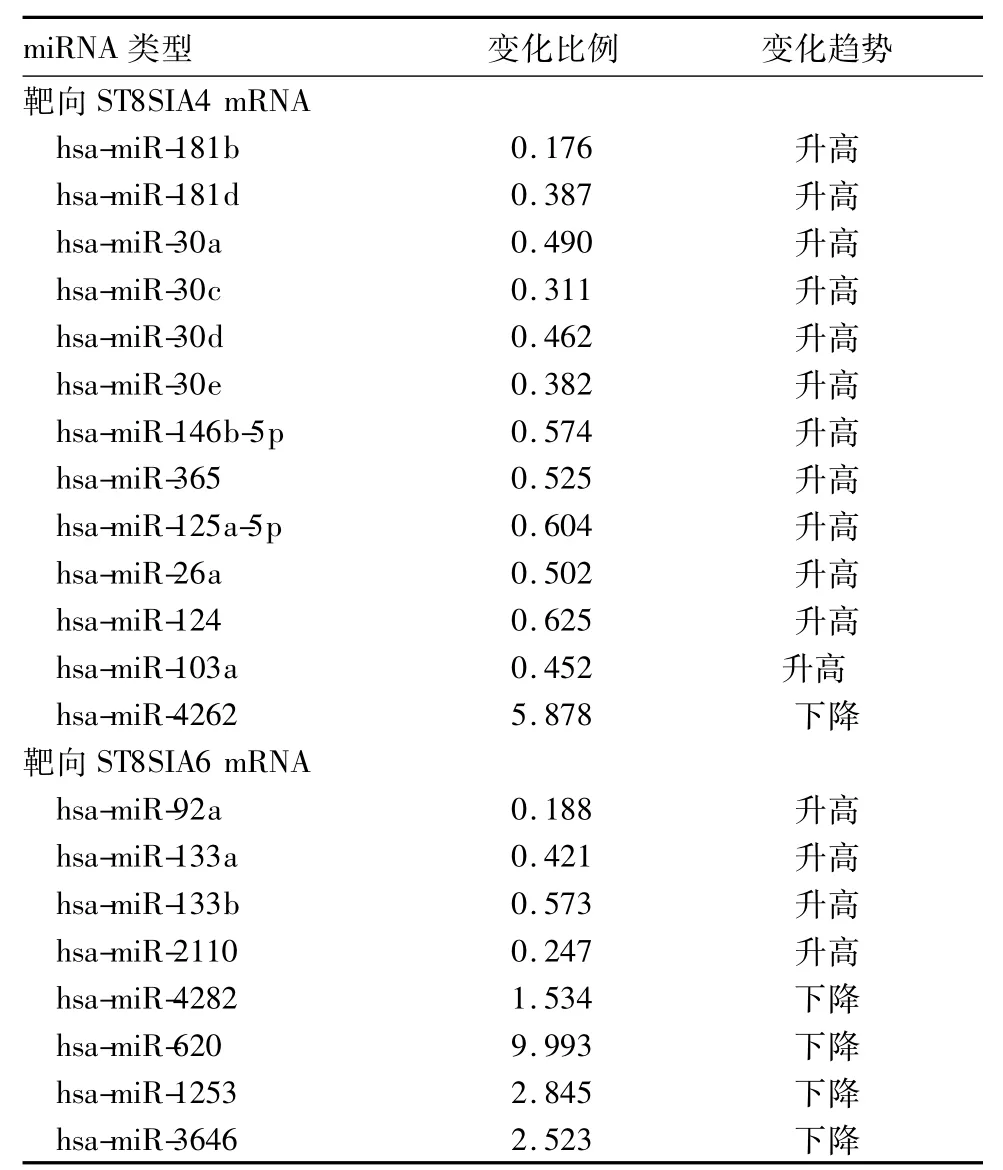系统性红斑狼疮患者外周血白细胞唾液酸转移酶表达变化及机制探讨
2016-01-20涂洋陈光亮曹珊陈晓翔上海交通大学医学院附属仁济医院上海200001
涂洋,陈光亮,曹珊,陈晓翔(上海交通大学医学院附属仁济医院,上海200001)
系统性红斑狼疮患者外周血白细胞唾液酸转移酶表达变化及机制探讨
涂洋,陈光亮,曹珊,陈晓翔
(上海交通大学医学院附属仁济医院,上海200001)
摘要:目的观察系统性红斑狼疮( SLE)患者外周血白细胞唾液酸转移酶( ST8SIA)的表达变化,并探讨其机制。方法选择SLE患者(观察组)和健康志愿者(对照组)各24例,采用RT-PCR法检测外周血白细胞ST8SIA1 ~6 mRNA;对有统计学意义的ST8SIA mRNA,采用基因芯片技术分析血浆中靶向其3'非翻译区( 3'UTR)的miRNA。结果两组外周血白细胞均无ST8SIA2、ST8SIA3、ST8SIA5 mRNA表达;观察组ST8SIA1、4、6 mRNA相对表达量分别为1.524±0.229、13.780±1.669、2.238±0.387,对照组分别为1.129±0.106、1.087±0.089、0.550± 0.054;两组ST8SIA4、6 mRNA比较,P均<0.05。靶向调节ST8SIA4 mRNA的miRNA表达下降12条、升高1条,靶向调节ST8SIA6 mRNA的miRNA表达下降、升高各4条。结论SLE患者外周血白细胞中ST8SIA4、ST8SIA6 mRNA表达升高,与对其进行靶向调控的miRNA表达异常有关。
关键词:系统性红斑狼疮;α2,8-唾液酸转移酶;微小核糖核酸;聚合酶链反应;基因芯片
Expression changes of sialyltransferase in peripheral blood leucocytes of patients with systemic lupus erythematosus and the possible mechanism.
TU Yang,CHEN Guang-liang,CAO Shan,CHEN Xiao-xiang
( Renji Hospital Affiliated to Shanghai Jiaotong University School of Medicine,Shanghai 200001,China)
Abstract:Objective To observe the expression changes of sialyltransferase ( ST8SIA) in the peripheral blood leucocytes of patients with systemic lupus erythematosus ( SLE) and to investigate the possible mechanism.Methods ST8SIA1-6 was detected by RT-PCR in the peripheral blood leucocytes in 24 SLE patients and 24 normal donors.We analyzed the miRNAs that targeting 3untranslated region ( UTR) by microarray chip.Results The expression of ST8SIA2,ST8SIA3 and ST8SIA5 was not detected in the peripheral blood leucocytes of the two groups.The relative expression levels of ST8SIA1 mRNA,ST8SIA4 mRNA and ST8SIA6 mRNA in the observation group were 1.524± 0.229,13.78±1.669 and 2.238±0.387,and they were 1.129±0.106,1.087±0.089 and 0.550±0.054 in the control group.The difference in ST8SIA4 mRNA and ST8SIA6 mRNA of the two groups was statistically different ( all P<0.05).There were 12 down-regulated plasma miRNAs that regulated the 3UTR of ST8SIA4 mRNA and 1 up-regulated plasma miRNA.There were 4 plasma miRNAs that made the 3UTR of ST8SIA6 mRNA down-regulated and 4 plasma miRNAs up-regulated.Conclusion The expression levels of ST8SIA4 mRNA and ST8SIA6 mRNA in patients with SLE are increased,which may be related with the abnormal expression of plasma miRNAs that can regulate the 3UTR of ST8SIA4 mRNA and ST8SIA6 mRNA.
Key words:systemic lupus erythematosus;α2,8-sialyltransferases; miRNA; polymerase chain reaction; microarray
系统性红斑狼疮( SLE)是一种原因未明,以多系统或器官病变和血清中出现大量致病性自身抗体为特征的自身免疫性疾病[1]。研究发现,SLE患者血浆中的IgG-Fc段唾液酸化程度比正常人降低,并且与SLE活动度呈负相关[2,3]。唾液酸转移酶( ST8SIA)是一种唾液酸糖基转移酶,共有6种亚型( ST8SIA1~6)。MicroRNAs( miRNAs)是在真核生物体内广泛存在的一类具有调控功能的小RNA。
成熟的miRNAs通过碱基互补配对方式识别特定mRNA的3'非翻译区( 3'UTR),使其降解或阻遏其翻译过程,从而调控基因表达[4,5]。研究发现很多疾病与miRNA表达水平有关,如心血管疾病、血液系统疾病、自身免疫性疾病等[6]。血浆miRNA具有耐RNA酶的特点,在血浆中稳定存在[7,8]。2013年1~6月,我们检测了SLE患者外周血白细胞ST8SIA表达变化,并分析血浆中对其进行靶向调节的miRNA水平,探讨ST8SIA表达变化的机制。
1 资料与方法
1.1临床资料收集我院同期收治的SLE患者24例(观察组),均为女性,年龄18~55岁,均符合2009年SLE诊断标准。排除重叠有其他结缔组织疾病者,原发造血系统疾病者,近期有外科手术、外伤者,肿瘤患者。对照组为24例女性健康志愿者,年龄18~55岁,均无自身免疫性疾病、感染、外伤及其他疾病。两组年龄、性别比例差异无统计学意义。
1.2方法
1.2.1外周血白细胞ST8SIA mRNA检测两组均于清晨空腹抽取外周肘正中静脉血5 mL,加红细胞裂解液裂红;采用TRIzol法提取1 μg总RNA,用Takara试剂盒进行逆转录。以核糖体蛋白L13 ( RPL13)为内参,采用RT-PCR法检测ST8SIA1~6 mRNA,操作均严格按照使用说明书进行。TRIzol购自Sigma公司,逆转录试剂盒及RT-PCR试剂盒均购自Takara公司,引物及内参均购自生工生物公司。以2-ΔΔCT表示其相对表达量。
1.2.2血浆靶向调节ST8SIA mRNA的miRNA检测两组均于清晨空腹抽取外周肘正中静脉血5 mL,3 000 r/m离心5 min;取1 mL血浆,采用TRIzol法提取3 μg总miRNA;然后进行标记、杂交,用Axon GenePix 4000B microarray scanner扫描检测荧光。从http://www.targetscan.org/中找到靶向1.2.1中有统计学意义ST8SIA mRNA 3'UTR的miRNA,使用GenePix Pro 6.0软件对miRNA芯片数据进行分析,并从基因芯片结果中逐个寻找其表达水平变化。
1.2.3统计学方法采用graphpad prism 5统计软件。计量数据以珋x±s表示,两组间比较采用t检验。P<0.05表示差异有统计学意义。
2 结果
2.1两组外周血白细胞ST8SIA mRNA表达比较两组外周血白细胞均无ST8SIA2、ST8SIA3、ST8SIA5 mRNA表达;两组外周血白细胞ST8SIA1、4、6 mRNA比较,见表1。
表1 两组ST8SIA mRNA表达水平比较(±s)

表1 两组ST8SIA mRNA表达水平比较(±s)
注:与对照组相比,*P<0.05。
组别ST8SIA1 mRNA ST8SIA4 mRNA ST8SIA6 mRNA观察组 1.524±0.229 13.780±1.669* 2.238±0.387*对照组1.129±0.106 1.087±0.089 0.550±0.054
2.2血浆靶向调节ST8SIA4、ST8SIA 6 mRNA的miRNA表达变化见表2。

表2 血浆靶向调节T8SIA4、ST8SIA 6 mRNA 的miRNA表达变化
3 讨论
研究发现,唾液酸转移酶在生物体内很多生理过程中发挥着重要作用,其可应用唾液酸供体单磷酸胞苷活化的唾液酸对不同的糖链结构进行唾液酸化修饰[9]。唾液酸的高表达会影响肿瘤细胞的黏附特性,从而使肿瘤细胞更易转移[10]。生物信息学预测发现,在外周血白细胞中ST8SIA1、ST8SIA4、ST8SIA6表达,而ST8SIA2、ST8SIA3、ST8SIA4不表达。本研究结果与生物信息学预测一致,并发现在外周血白细胞中ST8SIA4和ST8SIA6表达比正常人升高。
ST8SIA4可以催化神经细胞黏附分子形成,在胎儿脑组织中高表达,在成人脑组织中表达较低,提示其在大脑发育中具有重要作用。ST8SIA4在其他胎儿组织中如肝、肺、肾中也表达,在成人组织如脾脏、胸腺和心脏中适度表达[11]。研究发现,ST8SIA4在肿瘤中表达异常。ST8SIA4位于5号常染色体长臂上21号染色区间。有研究者发现,成人T淋巴细胞白血病该区域异常表达,提示ST8SIA4可能参
与T淋巴细胞的增殖[12]。ST8SIA6与细胞之间的交流、相互反应、黏附和蛋白质定位有关,影响淋巴细胞和树突细胞的相互反应和活化,从而对免疫功能产生影响[13,14]。研究发现,ST8SIA6是T细胞成熟过程中一种关键的唾液酸转移酶;干扰造血干细胞中ST8SIA6表达,发现尽管能够产生B细胞和骨髓细胞,但是T细胞发育完全受阻[15]。由此推测,SLE患者ST8SIA4和ST8SIA6高表达,使T细胞增殖活跃,导致免疫紊乱,与SLE发病机制有关。尽管SLE患者外周血白细胞中ST8SIA4和ST8SIA6 mRNA表达水平升高,但是SLE患者的血浆IgG-Fc段唾液酸化程度较正常人降低,其可能原因是唾液酸转移酶的mRNA翻译为蛋白质的过程受阻,或者唾液酸转移酶对糖链结构进行唾液酸化修饰时发生功能障碍,其具体机制需要进一步研究。
血浆中的miRNA存在于各种载体中,这些包含miRNA的载体犹如“特洛伊木马”,其中的蛋白成分因具有抗原活性而能够诱导机体免疫激活;载体可被单核巨噬细胞、树突状细胞等靶细胞摄入,然后释放其中的miRNA;以该种机制逃避机体对其清除,从而达到调控靶细胞分化及免疫功能[16]。通过对基因芯片分析发现,血浆中许多靶向ST8SIA4、ST8SIA6 mRNA 3'UTR的miRNA水平均发生改变,提示起关键调控作用的miRNA表达水平下降,对ST8SIA4 mRNA和ST8SIA6 mRNA的降解和阻遏其翻译过程的能力减弱,从而导致ST8SIA4 mRNA和ST8SIA6 mRNA表达水平升高。因此,SLE患者体内miRNA表达异常,可导致体内唾液酸转移酶表达升高,进而影响体内免疫细胞反应和活化,从而对免疫功能产生影响,参与SLE发病过程。下一步我们将研究能够调控唾液酸转移酶表达水平的miRNA,进而探索miRNA如何通过唾液酸转移酶途径参与SLE的发病。
参考文献:
[1]Bennett L,Karolina PA,Arce E,et al.Interferon and granulopoiesis signatures in systemic lupus erythematosus blood[J].J Exp Med,2003,197( 6) : 711-723.
[2]陈玉强,陈晓翔,王元.血浆丙种球蛋白Fc段唾液酸化水平及其临床意义[J].中华风湿病学杂志,2009,13( 9) : 4.
[3]Lawrie CH.MicroRNAs and haematology: small molecules,big function[J].Br J Haematol,2007,137( 6) : 503-512.
[4]Lim LP,Lau NC,Grimson A,et al.Microarray analysis shows that some microRNAs downregulate large numbers of target mRNAs [J].Nature,2005,433( 7027) : 769-773.
[5]Wheeler DL.Database resources of the National Center for Biotechnology Information[J].Nucleic Acids Res,2007,15( 7) : 73-85.
[6]Chen X,Ba Y,Ma L,et al.Characterization of microRNAs in serum: a novel class of biomarkers for diagnosis of cancer and other diseases[J].Cell Res,2008,18( 10) : 997-1006.
[7]Mitchell PS,Parkin RK,Kroh EM,et al.Circulating microRNAs as stable blood-based markers for cancer detection[J].Proc Natl Acad Sci USA,2008,105( 30) : 10513-10518.
[8]Valadi H,Ekstrm K,Bossios A,et al.Exosome-mediated transfer of mRNAs and microRNAs is a novel mechanism of genetic exchange between cells[J].Nat Cell Biol,2007,9( 6) : 654-649.
[9]Hsu FC,Shapiro MJ,Chen MW,et al.Immature recent thymic emigrants are eliminated by complement[J].J Immunol,2014,193( 12) : 6005-6015.
[10]Biesen R,Demir C,Barkhudarova F,et al.Sialic acid-binding Iglike lectin 1 expression in inflammatory and resident monocytes is a potential biomarker for monitoring disease activity and success of therapy in systemic lupus erythematosus[J].Arthritis Rheum,2008,58( 4) : 1136-1145.
[11]Angata K,Nakayama J,Fredette B,et al.Human STX polysialyltransferase forms the embryonic form of the neural cell adhesion molecule: tissuespecific expression,neurite outgrowth,and chromosomal localization in comparison with another polysialyltransferase,PST[J].J Biol Chem,1997,272( 11) : 7182-7190.
[12]Kjeldsen E,Roug AS.A novel unbalanced de novo translocation der( 5) t( 4; 5) ( q26; q21.1) in adult T-cell precursor lymphoblastic leukemia[J].Mol Cytogenet,2012,5( 1) : 21.
[13]Angata K,Suzuki M,Fukuda M.Differential and cooperative polysialylation of the neural cell adhesion molecule by two polysialyltransferases,PST and STX[J].J Biol Chem,1998,273( 43) : 28524-28532.
[14]Angata K,Suzuki M,Mc Auliffe J,et al.Differential biosynthesis of polysialic acid on NCAM and oligosaccharide acceptors by three distinct a2,8-sialyltransferases,PST ( ST8Sia-IV),STX ( ST8Sia-Ⅱ),and ST8Sia-Ⅲ[J].J Biol Chem,2000,275( 24) : 18594-18601.
[15]Yeh J,Cummings RD.Differential recognition of glycoprotein acceptors by terminal glycosyltransferases[J].Glycobiology,1997,7 ( 2) : 241-251.
[16]Valadi H,Ekstrm K,Bossios A,et al.Exosome-mediated transfer of mRNAs and microRNAs is a novel mechanism of genetic exchange between cells[J].Nature Cell Biology,2007,9( 6) : 654-659.
收稿日期:( 2015-04-20)
通信作者简介:陈晓翔( 1952-),男,副教授,硕士生导师,研究方向为为系统系红斑狼疮发病机制。E-mail: xiaoxiang0721@126.com
作者简介:第一涂洋( 1988-),男,硕士研究生,研究方向为系统性红斑狼疮发病机制。E-mail: tuyangzzu@126.com
基金项目:国家自然科学基金资助项目( 81273306)。
文章编号:1002-266X( 2015)30-0017-03
文献标志码:A
中图分类号:R593
doi:10.3969/j.issn.1002-266X.2015.30.006
